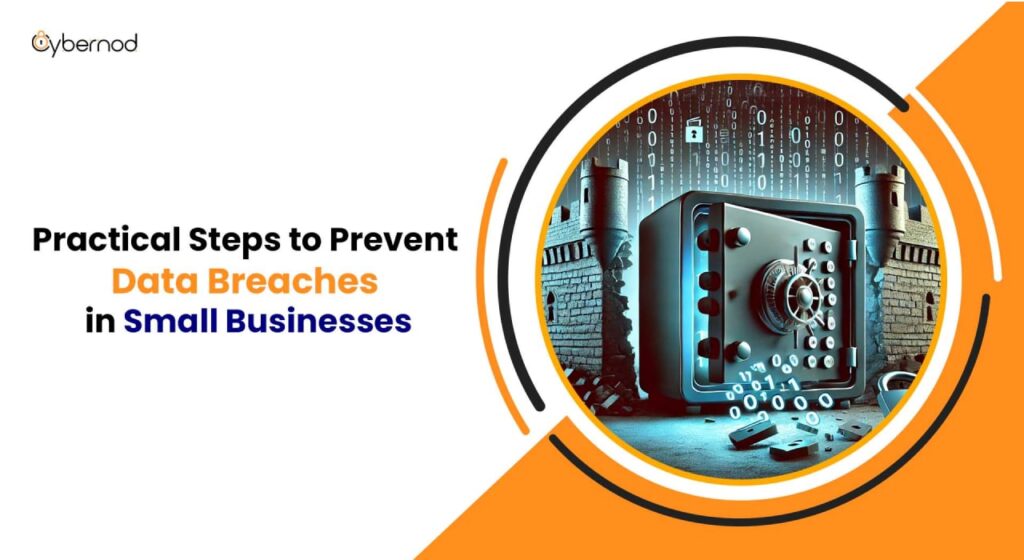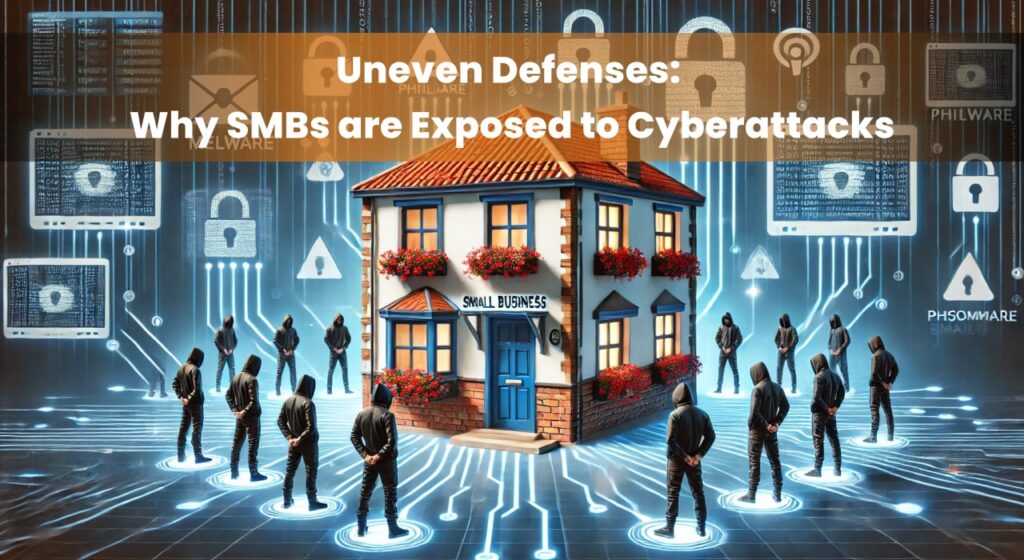
The digital landscape offers immense opportunities for small and medium-sized businesses (SMBs) to thrive. However, this interconnected environment also exposes them to a heightened risk of cyberattacks. According to a 2023 Verizon Business Insider Threat Report, 43% of data breaches involved SMBs, highlighting their vulnerability. These attacks can have devastating consequences. A Ponemon Institute study revealed that the average cost of a data breach for an SMB in 2023 reached $4.24 million, a significant financial burden for smaller businesses.
Beyond the immediate financial impact, data breaches can erode customer trust and damage an SMB’s reputation for years to come. Public exposure of sensitive customer information or operational disruption caused by ransomware attacks can severely tarnish a brand’s image.
This guide recognizes the challenges faced by SMBs with limited resources. The following sections outline practical steps that any SMB can implement to significantly bolster their cybersecurity posture, mitigating the risk of data breaches and safeguarding their financial well-being and reputation.
Why Are Small Businesses Vulnerable?

While large corporations often possess the resources to invest in robust cybersecurity defenses, SMBs frequently find themselves exposed. This vulnerability stems from several key factors. Unlike their larger counterparts, SMBs often lack the budget to implement comprehensive cybersecurity infrastructure, including firewalls, intrusion detection systems, and data encryption solutions. This creates a digital perimeter with weaker fortifications, making it easier for hackers to infiltrate the network. Furthermore, SMBs may have limited access to in-house IT expertise. This lack of knowledge can make it difficult to stay abreast of the latest cyber threats and implement appropriate security protocols.
The data SMBs possess can also make them attractive targets. Customer information, financial records, and intellectual property are all valuable assets that hackers can exploit for financial gain. Malicious actors may attempt to sell this information on the dark web or use it to commit identity theft.
Beyond these general vulnerabilities, several common attack methods specifically target SMB weaknesses. Phishing emails, designed to appear legitimate, can trick employees into revealing sensitive information or clicking on malicious links that download malware. Malware, a type of malicious software, can wreak havoc on a network, stealing data, disrupting operations, and holding files hostage with ransomware attacks. Additionally, unpatched software with known vulnerabilities can provide a backdoor for hackers to gain access to a system. Finally, physical security breaches, such as stolen laptops or unauthorized access to data centers, can also compromise sensitive information.
To effectively address these vulnerabilities, SMBs should consider conducting a security gap analysis. This analysis involves a comprehensive evaluation of an organization’s IT infrastructure, security policies, and employee behavior to identify potential weaknesses that attackers could exploit. By pinpointing these gaps, SMBs can prioritize their limited resources and take targeted actions to bolster their cybersecurity posture.
Conducting a Cybersecurity Risk Assessment

A cybersecurity risk assessment is a fundamental step in safeguarding your SMB from data breaches. It’s a methodical process that evaluates the likelihood and impact of potential cyberattacks on your organization’s critical data assets. By proactively identifying vulnerabilities, a risk assessment allows you to prioritize resources and implement appropriate security controls to mitigate these risks.
Here’s a simplified, step-by-step approach to conducting a cybersecurity risk assessment for your SMB:
Step 1: Identify Critical Data Assets
Begin by pinpointing the most sensitive information your business possesses. This could include customer databases, financial records, intellectual property, and any other data essential for your operations. Consider the legal and financial ramifications of a breach for each data type.
Step 2: Examine Existing Security Controls
Evaluate the current security measures you have in place to protect your data. This includes firewalls, antivirus software, access control protocols (who can access what data), and data encryption practices. Assess the effectiveness of these controls and identify any potential gaps.
Step 3: Analyze Potential Threats and Vulnerabilities
Next, consider the various cyber threats your SMB might face. Phishing emails, malware attacks, unpatched software, and unauthorized access attempts are all common threats. Analyze how these threats could exploit existing vulnerabilities in your security controls and potentially compromise your data.
| Data Asset | Threat | Potential Consequences |
|---|---|---|
| Customer Information (names, addresses, credit card details) | Phishing attacks, malware | Identity theft, financial fraud, reputational damage |
| Financial Records (bank account details, tax returns) | Malware, unauthorized access | Loss of funds, financial penalties, legal repercussions |
| Intellectual Property (trade secrets, product designs) | Data breaches, industrial espionage | Competitive disadvantage, loss of revenue, product development delays |
Step 4: Develop a Mitigation Plan
Based on the identified risks, prioritize vulnerabilities and develop a plan to address them. This plan might involve implementing additional security controls, employee training programs on cyber awareness, or updating outdated software.
Fortunately, numerous free online tools and templates are available to help SMBs conduct a cybersecurity risk assessment. The National Institute of Standards and Technology (NIST) offers a Cybersecurity Framework that provides a structured approach to identify, protect, detect, respond to, and recover from cyberattacks. Additionally, the Small Business Administration (SBA) provides resources and guidance on cybersecurity for SMBs.
By dedicating time and resources to a cybersecurity risk assessment, your SMB can gain valuable insights into its vulnerabilities and take proactive steps to prevent a data breach, protecting its critical data and future success.
While a cybersecurity risk assessment provides a solid foundation for understanding your vulnerabilities, a gap analysis delves even deeper. This methodical evaluation pinpoints the exact discrepancies between your current security measures and industry best practices.
By identifying these gaps, you can prioritize your resources and address the most critical weaknesses before they are exploited by cybercriminals.
Learn more about conducting a cybersecurity gap analysis specifically tailored for small businesses in our comprehensive guide: [Gap Analysis in Cyber Security: A Strategic Approach for Small Businesses]
Implementing Practical Data Breach Prevention Measures

While sophisticated security solutions exist, robust data breach prevention for SMBs doesn’t necessitate an exorbitant cybersecurity budget. Here’s a breakdown of practical measures that can significantly enhance your defenses:
Fortify Core Defenses
The foundation of any cybersecurity strategy lies in establishing strong access controls. Enforce the use of complex passwords for all user accounts, incorporating a mix of uppercase and lowercase letters, numbers, and symbols. Multi-factor authentication (MFA) adds an extra layer of security by requiring a secondary verification step beyond just a password a code sent to a phone or a fingerprint scan, for example. This significantly reduces the risk of unauthorized access even if a password is compromised.
Regular software updates are paramount in patching security vulnerabilities that hackers can exploit. Imagine a software program as a castle wall. Updates are like regularly repairing cracks that appear in the wall, preventing intruders from gaining easy access. Develop a system for keeping operating systems, applications, and firmware on all devices up-to-date. This might involve scheduling automatic updates or designating a specific time for manual updates .

Firewalls act as a digital gatekeeper, filtering incoming and outgoing traffic on your network. They can block malicious attempts to access your systems. Antivirus software proactively scans for and neutralizes malware that could compromise your data. While not foolproof, these tools are essential components of a strong cybersecurity posture.
Securing Data Access and Storage
The principle of least privilege dictates that users should only have access to the data they need to perform their jobs. Implement granular access controls to restrict employee access to sensitive information based on their roles. This minimizes the potential damage if a single account is compromised.
Data encryption scrambles information into an unreadable format, rendering it useless to unauthorized parties even if they manage to steal it. Encrypt data at rest (stored on devices) and in transit (transferred over networks) for an additional layer of security.
Many SMBs leverage cloud storage solutions for its scalability and cost-effectiveness. However, it’s crucial to choose reputable cloud service providers with robust security practices. Carefully evaluate a vendor’s security certifications and data encryption protocols before entrusting them with your business information.
Employee Awareness and Training
Employees are often the first line of defense against cyberattacks. Phishing emails, for instance, rely on social engineering tactics to trick employees into revealing sensitive information or clicking on malicious links. Educating your employees on these tactics and best practices for cybersecurity hygiene is crucial. Regularly conduct security awareness training to keep employees informed about the latest threats and how to identify and report suspicious activity. These training sessions can also help SMBs comply with various data privacy regulations that mandate employee training on cybersecurity.
Backup and Recovery Plan
No security system is infallible. Having a robust backup and recovery plan in place minimizes downtime and data loss in the unfortunate event of a cyberattack. Regularly back up your critical data to a secure, off-site location, such as a cloud storage service or a separate physical drive. Consider different backup methods based on your needs, such as full system backups or incremental backups that capture only the changes since the last backup. Equally important is testing your recovery process regularly to ensure you can restore your data efficiently in a crisis.
By implementing these practical measures, SMBs can significantly bolster their cybersecurity posture and mitigate the risk of data breaches. Remember, cybersecurity is an ongoing process, not a one-time fix. Regularly review your security controls, stay informed about evolving threats, and adapt your strategies accordingly.
Cybersecurity is an ongoing process, not a one-time fix. By implementing the practical measures outlined in this guide, SMBs can significantly bolster their defenses against data breaches and safeguard their valuable assets. Remember, even small businesses are attractive targets for hackers.
Regularly conduct security assessments to identify and address any emerging vulnerabilities. Revisit and update your data breach prevention plan as your business grows and your data landscape evolves. By remaining vigilant and proactive, SMBs can take control of their cybersecurity posture and mitigate the risk of a devastating attack.
Categorized in:
Comments